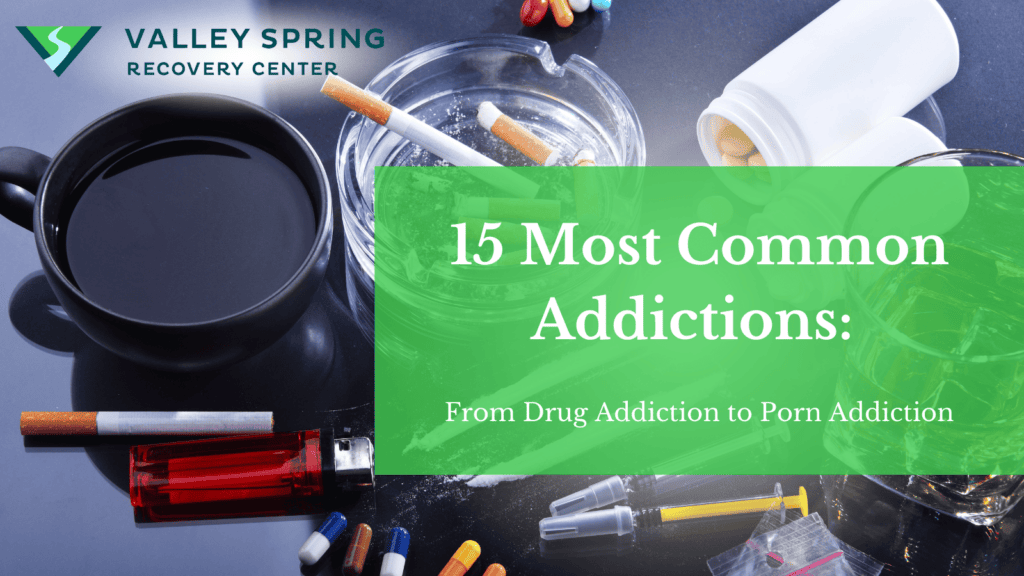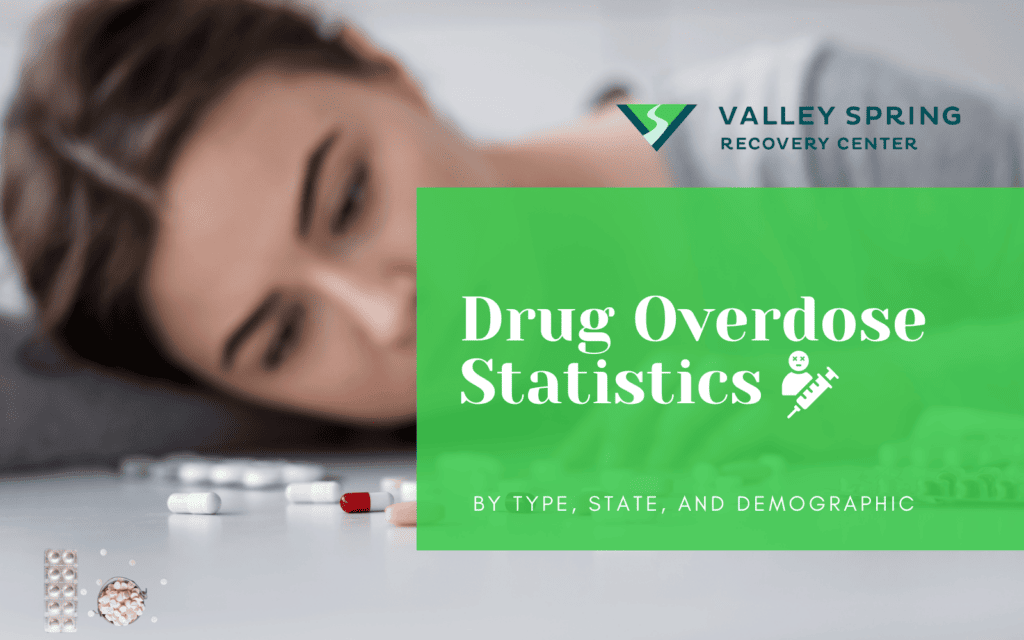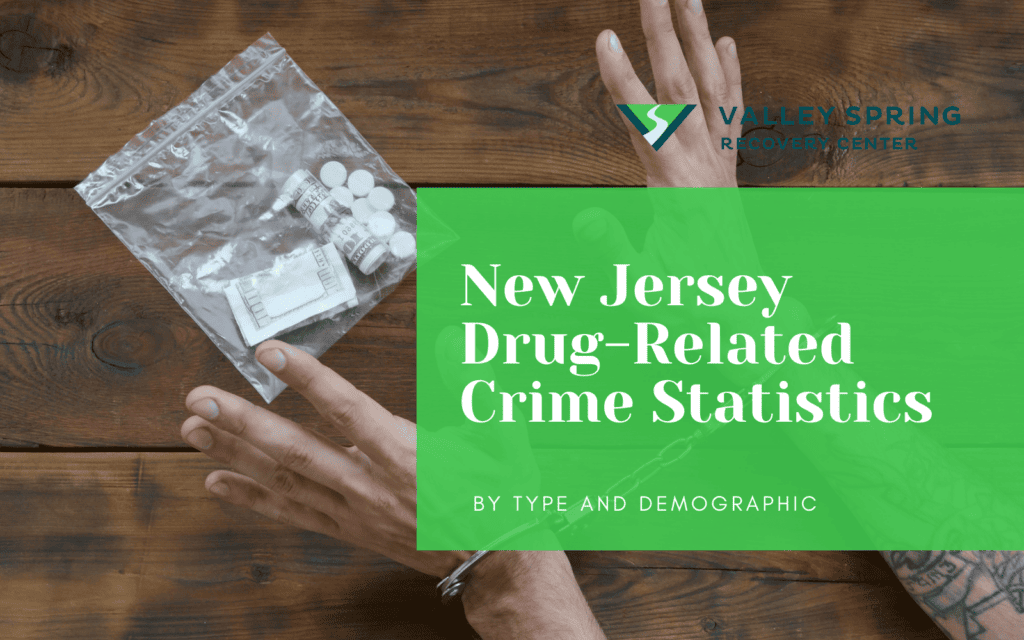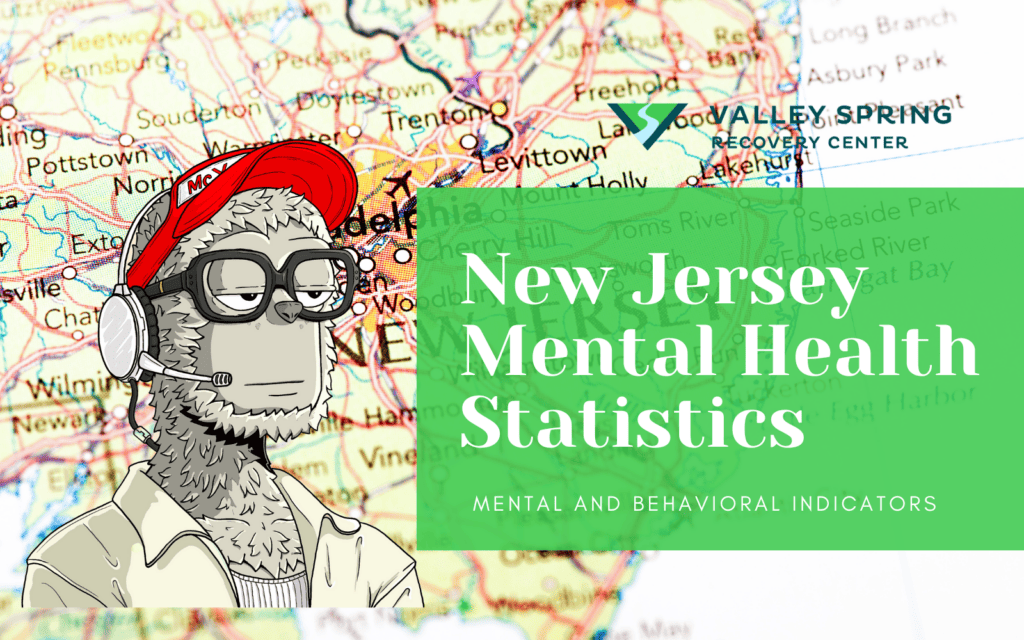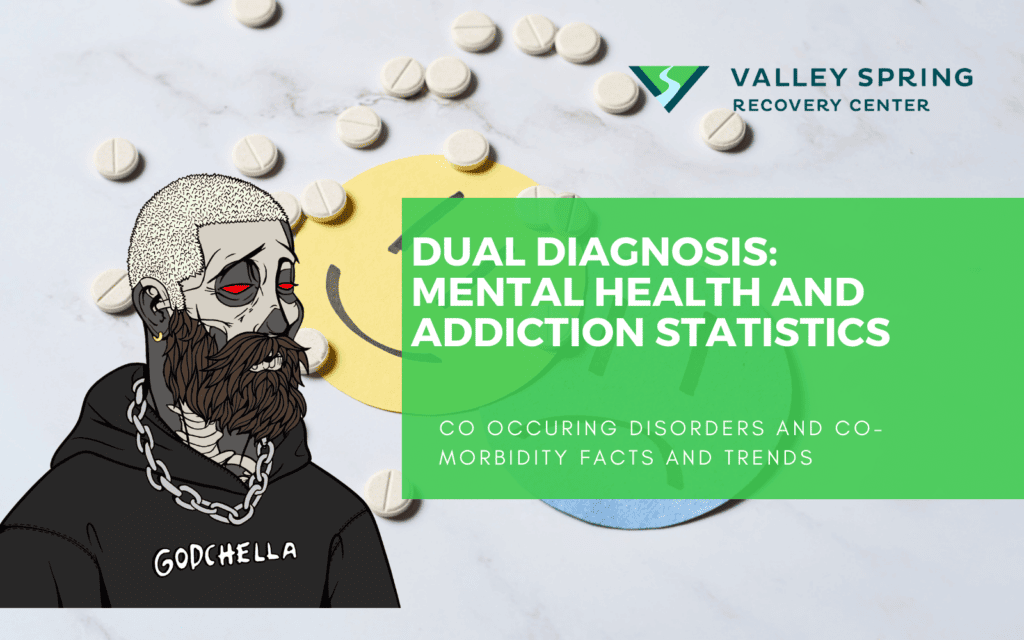Addiction remains one of the most pressing health crises worldwide, with alcohol addiction being particularly pervasive. According to the World Health Organization (WHO), in 2018, over 3 million deaths were attributed to alcohol consumption, representing 5.3% of all deaths globally. This statistic underscores the critical nature of addiction as a global health concern and sets the stage for a deeper understanding of the most common types of addiction.
Ranging from drug and alcohol dependency to behavioral compulsions such as gambling, to internet use, and shopping. Understanding these different forms of addiction is crucial in the global effort to manage and treat them effectively. The intricate nature of addiction underscores the necessity for heightened awareness and the development of comprehensive strategies to tackle this widespread concern.
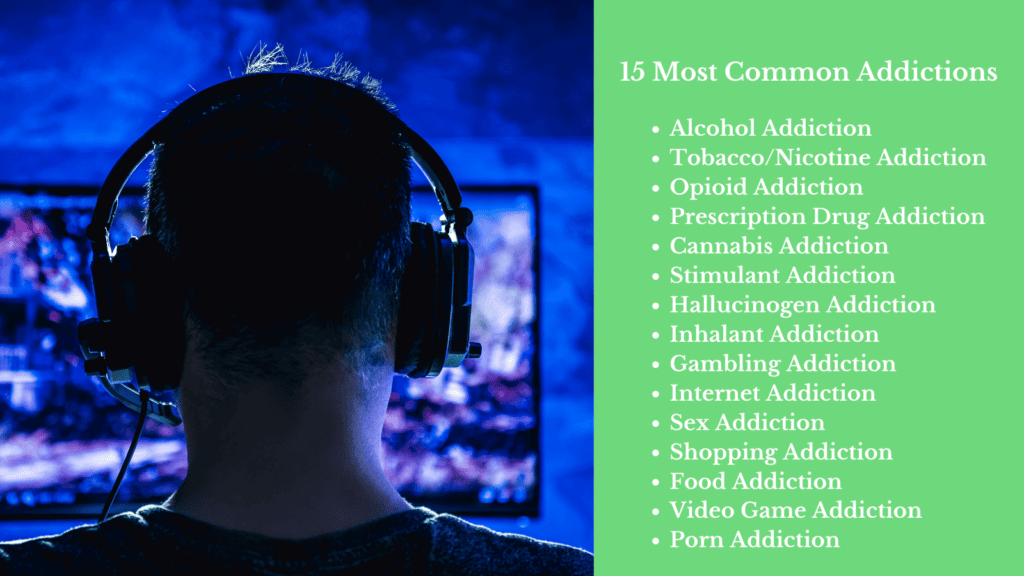
1. Alcohol Addiction
Alcohol addiction, or Alcohol Use Disorder (AUD), is characterized by an intense craving for alcohol and an inability to control consumption despite the negative effects on health and social life. It’s not only the most common addiction but also one of the most dangerous, leading to severe long-term health issues such as liver disease, cardiovascular problems, and neurological damage. The societal impact is equally significant, affecting families and communities through increased violence, accidents, and social disintegration.
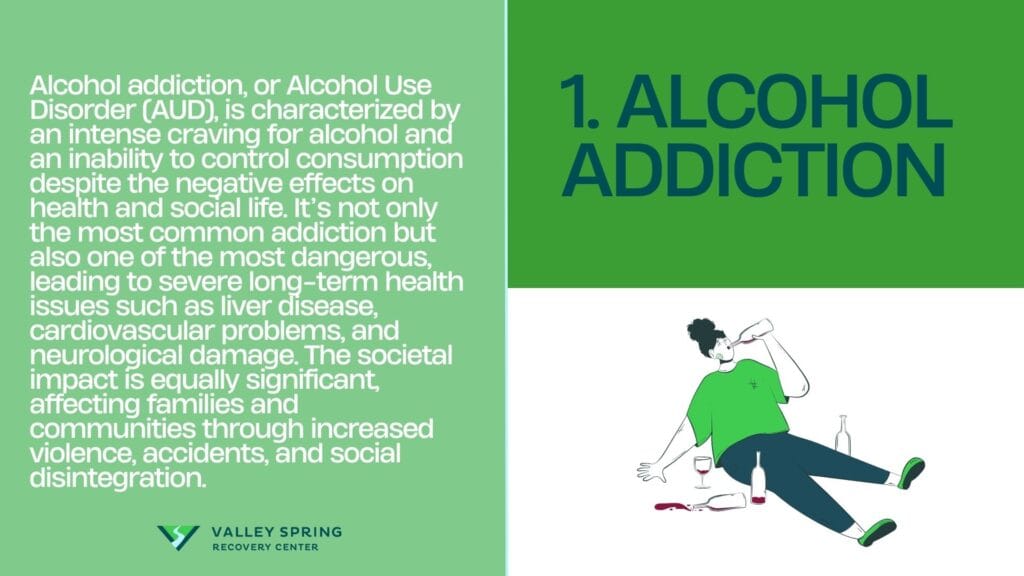
Over 3 million deaths annually are attributed to alcohol use, representing 5.3% of all deaths globally (World Health Organization, 2018). This highlights the severe global impact of Alcohol Use Disorder (AUD), characterized by an inability to control alcohol consumption despite its negative effects on health and social life.
2. Tobacco/Nicotine Addiction
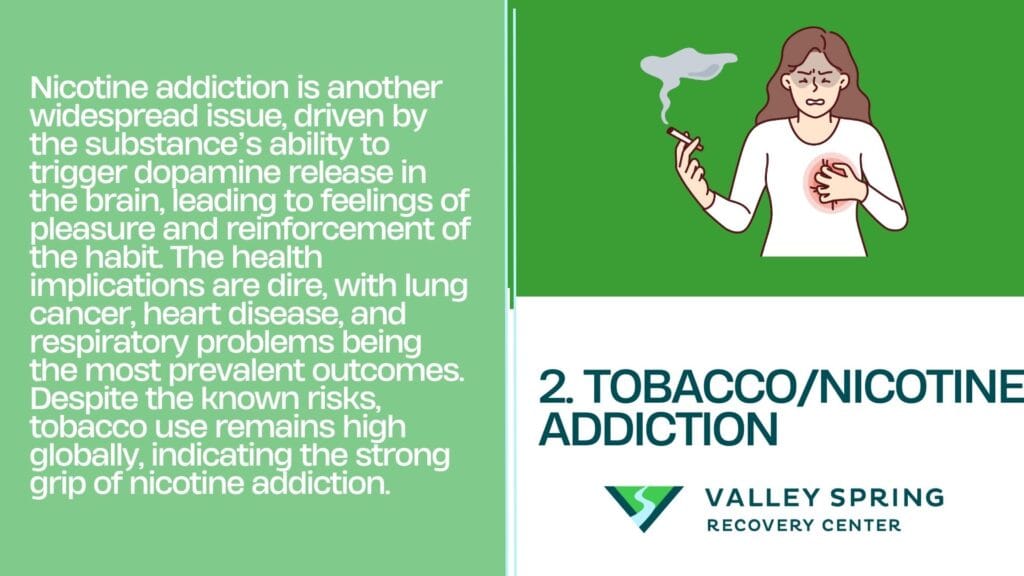
Nicotine addiction ranks number 2 on the most widespread addiction list, driven by the substance’s ability to trigger dopamine release in the brain, leading to feelings of pleasure and reinforcement of the habit. The health implications are dire, with lung cancer, heart disease, and respiratory problems being the most prevalent outcomes. Despite the known risks, tobacco use remains high globally, indicating the strong grip of nicotine addiction.
With more than 8 million deaths each year worldwide due to tobacco use, nicotine addiction remains a major public health challenge (World Health Organization, 2021). The addictive nature of nicotine leads to diseases such as lung cancer, heart disease, and respiratory problems.
3. Opioid Addiction
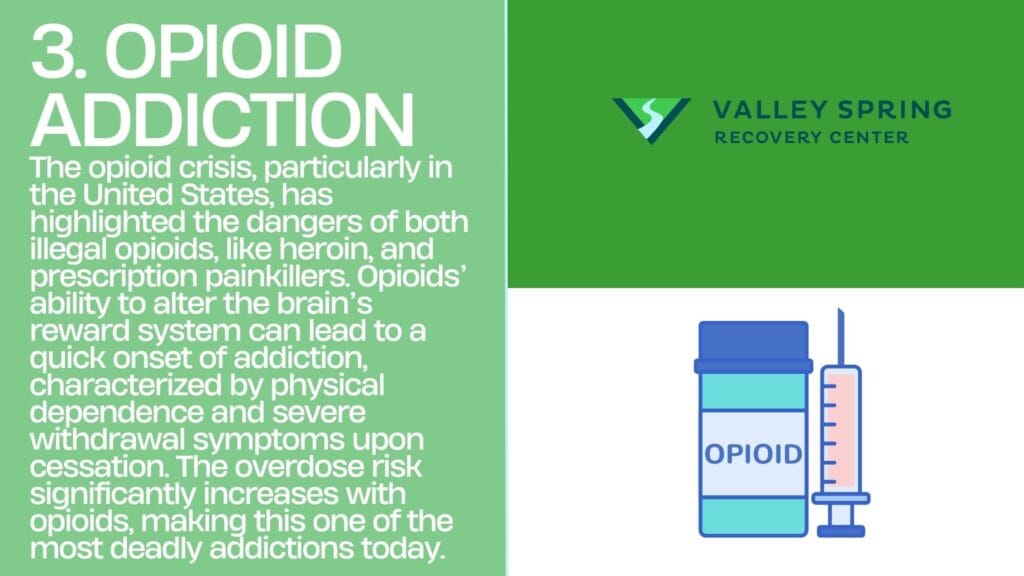
The opioid crisis, particularly in the United States, has highlighted the dangers of both illegal opioids, like heroin, and prescription painkillers ranking it number 3 on the list of most frequent addictions. Opioids’ ability to alter the brain’s reward system can lead to a quick onset of addiction, characterized by physical dependence and severe withdrawal symptoms upon cessation. The overdose risk significantly increases with opioids, making this one of the most deadly addictions today.
In the United States, opioids were involved in nearly 49,000 opioid-related overdose deaths accounting for 70% of all drug overdose deaths in 2019, showcasing the severity of the opioid crisis (Centers for Disease Control and Prevention, 2020). This includes addiction to both illegal drugs like heroin and prescription painkillers.
4. Prescription Drug Addiction
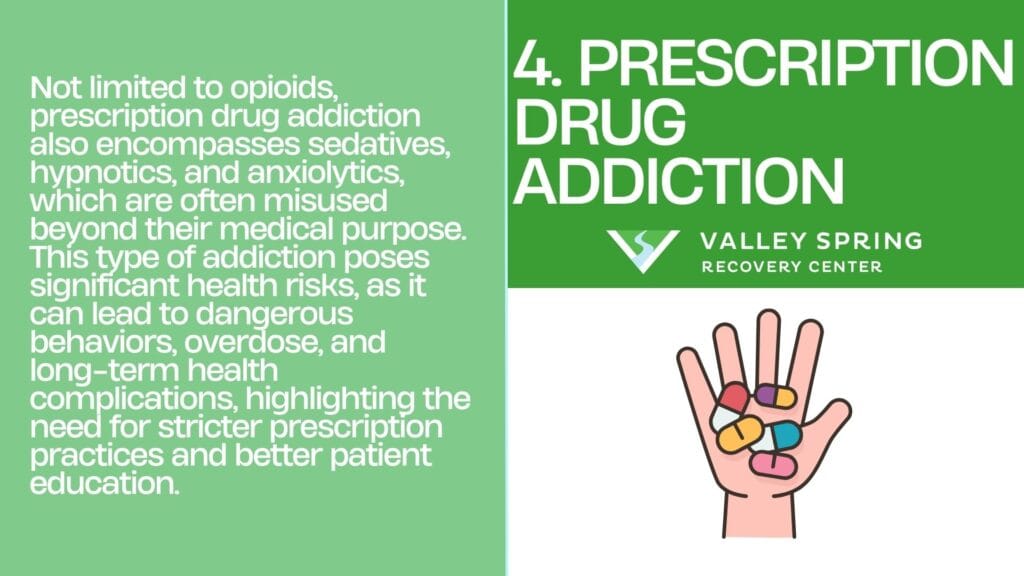
Not limited to opioids, prescription drug addiction also encompasses sedatives, hypnotics, and anxiolytics, which are often misused beyond their medical purpose. This type of addiction poses significant health risks, as it can lead to dangerous behaviors, overdose, and long-term health complications, highlighting the need for stricter prescription practices and better patient education.
It is estimated that 18 million people have misused prescription medications at least once in the past year (National Institute on Drug Abuse, 2021). This involves dependency on medications not taken as prescribed, including sedatives, hypnotics, or anxiolytics.
According to a hydrocodone addiction statistics study conducted by Valley Spring Recovery Center, Around 11 million people have used pain relievers without a prescription in 2018.
5. Cannabis Addiction
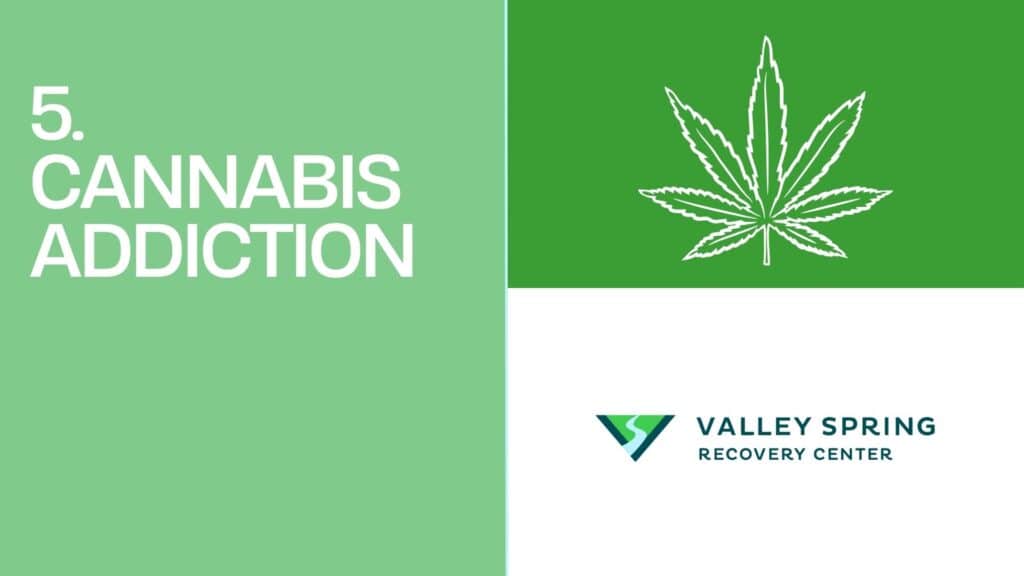
While often perceived as less harmful, cannabis addiction is a growing concern, especially with the increasing legalization and availability of marijuana. Long-term or heavy use can lead to addiction, characterized by a dependence that affects cognitive abilities and mental health. The debate around cannabis addiction continues, but the potential for abuse and negative health outcomes warrants attention.
Around 30% of those who use marijuana may have some degree of marijuana use disorder (National Institute on Drug Abuse, 2020). People who begin using marijuana before the age of 18 are four to seven times more likely to develop a marijuana use disorder than adults.
6. Stimulant Addiction
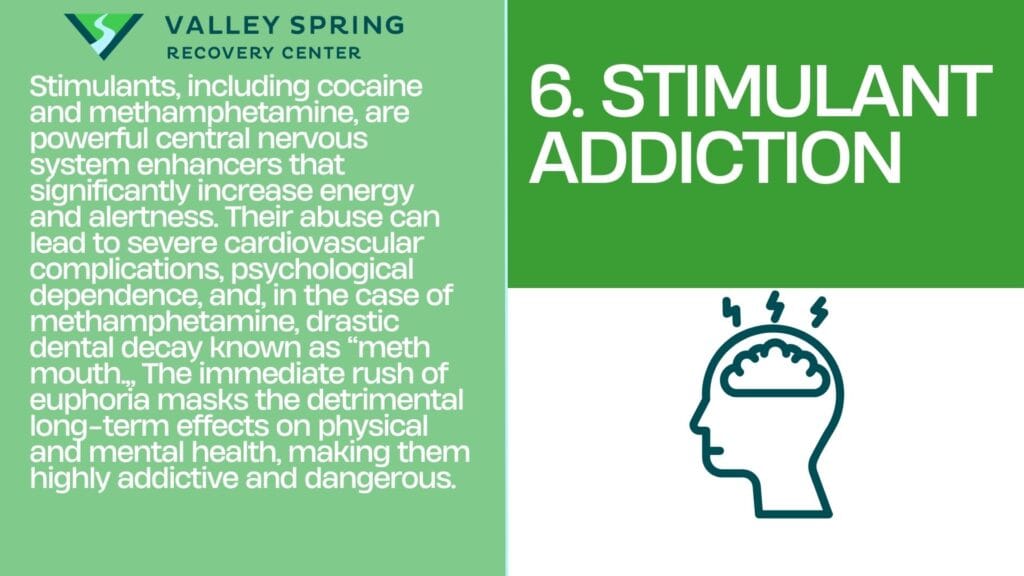
Stimulants, including cocaine and methamphetamine, are powerful central nervous system enhancers that significantly increase energy and alertness. Their abuse can lead to severe cardiovascular complications, psychological dependence, and, in the case of methamphetamine, drastic dental decay known as “meth mouth.” The immediate rush of euphoria masks the detrimental long-term effects on physical and mental health, making them highly addictive and dangerous.
Cocaine was involved in 1 in 5 overdose deaths in 2018, indicating the high risk of stimulant addiction (National Institute on Drug Abuse, 2020). Drugs like cocaine or methamphetamine stimulate the central nervous system and can lead to heart problems and psychological dependence.
7. Hallucinogen Addiction
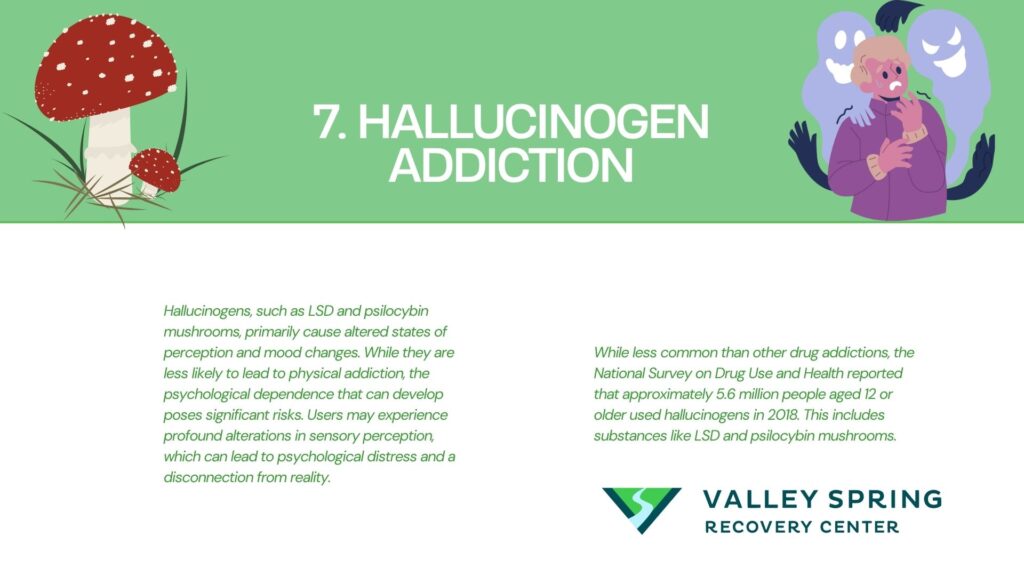
Hallucinogens, such as LSD and psilocybin mushrooms, primarily cause altered states of perception and mood changes. While they are less likely to lead to physical addiction, the psychological dependence that can develop poses significant risks. Users may experience profound alterations in sensory perception, which can lead to psychological distress and a disconnection from reality.
While less common than other drug addictions, the National Survey on Drug Use and Health reported that approximately 5.6 million people aged 12 or older used hallucinogens in 2018. This includes substances like LSD and psilocybin mushrooms.
8. Inhalant Addiction
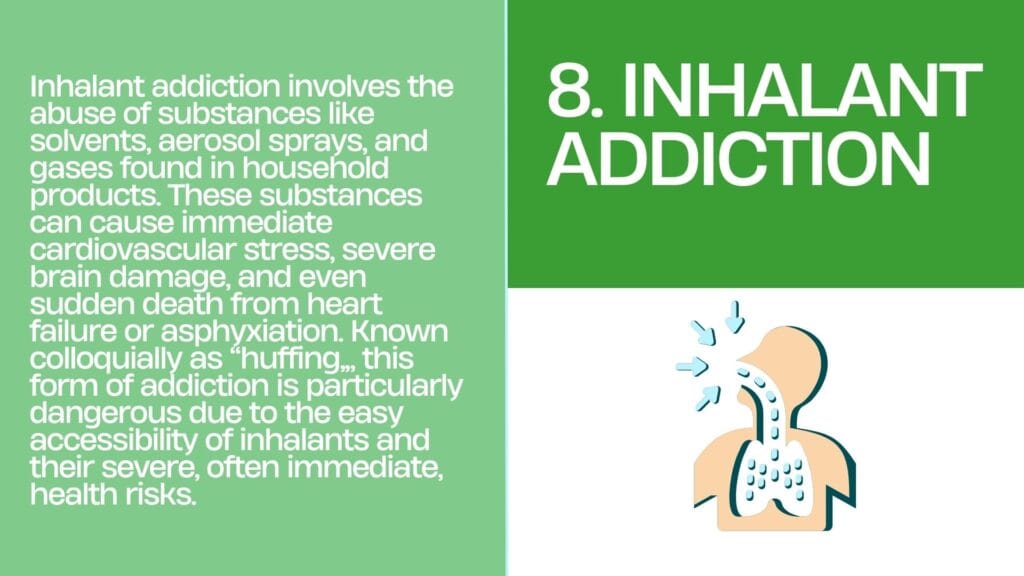
Inhalant addiction involves the abuse of substances like solvents, aerosol sprays, and gases found in household products. These substances can cause immediate cardiovascular stress, severe brain damage, and even sudden death from heart failure or asphyxiation. Known colloquially as “huffing,” this form of addiction is particularly dangerous due to the easy accessibility of inhalants and their severe, often immediate, health risks.
Inhalant use is most common among adolescents, with 9.4% of 8th graders reporting having used inhalants at least once in their lives (Monitoring the Future Survey, 2020). Inhalants can cause immediate heart problems, brain damage, and sudden death.
9. Gambling Addiction
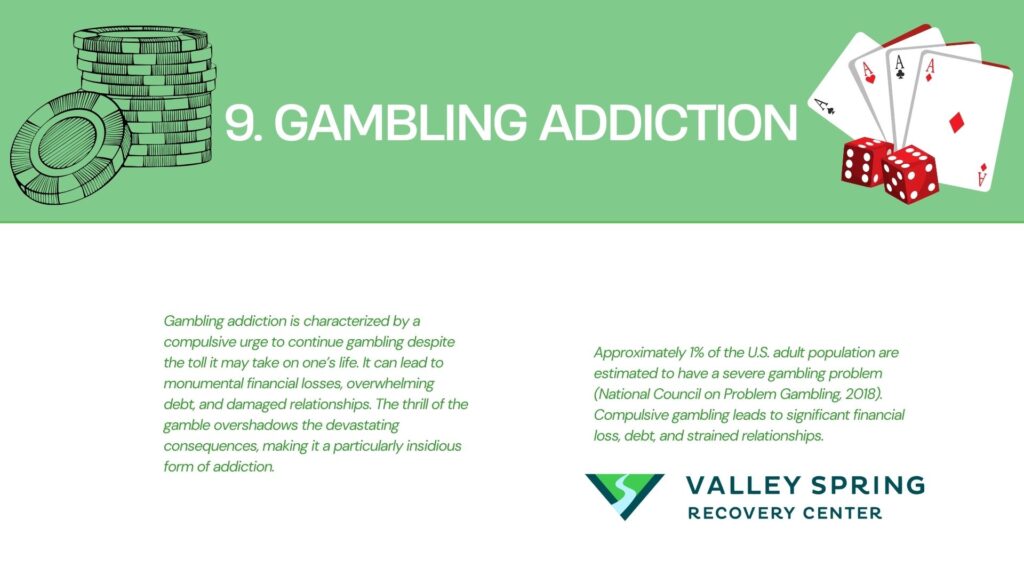
Gambling addiction is characterized by a compulsive urge to continue gambling despite the toll it may take on one’s life. It can lead to monumental financial losses, overwhelming debt, and damaged relationships. The thrill of the gamble overshadows the devastating consequences, making it a particularly insidious form of addiction.
Approximately 1% of the U.S. adult population are estimated to have a severe gambling problem (National Council on Problem Gambling, 2018). Compulsive gambling leads to significant financial loss, debt, and strained relationships.
10. Internet Addiction
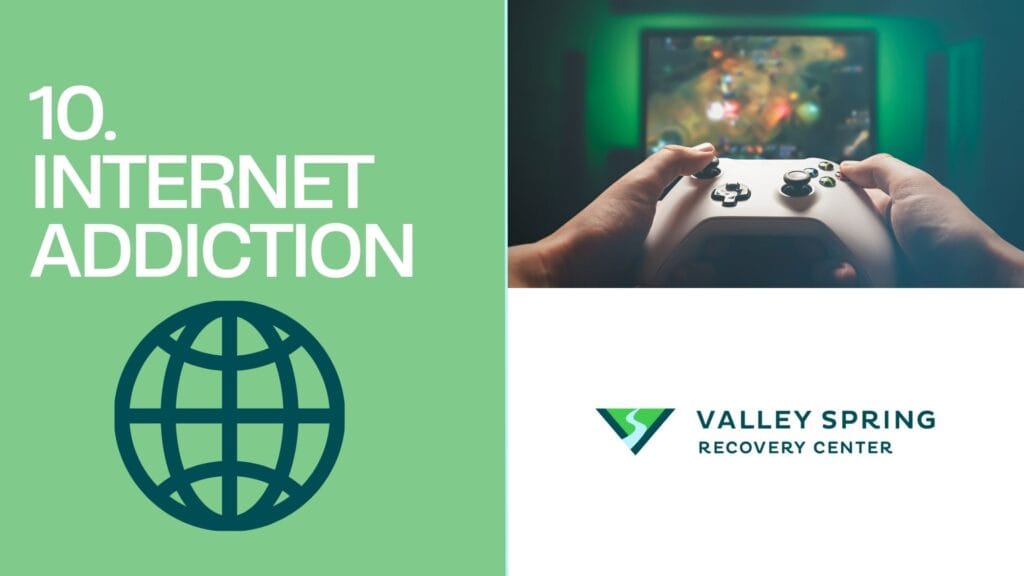
With the digital age in full swing, internet addiction has emerged as a significant concern. It’s defined by excessive use of the internet that interferes with daily life, leading to social isolation, mood changes, and adverse effects on physical health due to a sedentary lifestyle. This addiction encompasses a range of activities, from social media usage to online gaming, reflecting its complex nature.
Studies suggest that internet addiction affects up to 8% of the general population in the United States and Europe (American Psychiatric Association, 2020). Excessive internet use can lead to social isolation, mood changes, and impacts on physical health.
11. Sex Addiction
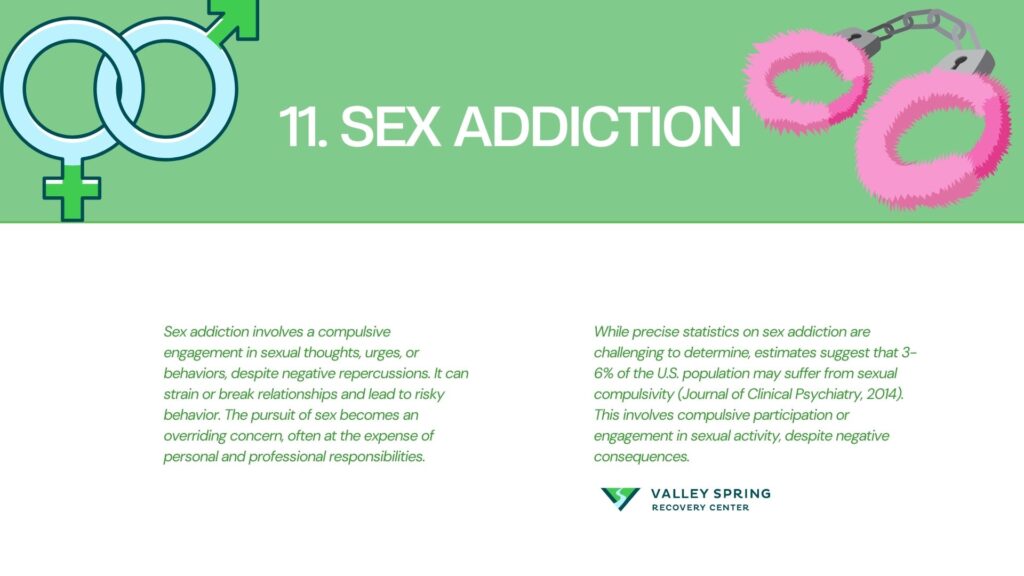
Sex addiction involves a compulsive engagement in sexual thoughts, urges, or behaviors, despite negative repercussions. It can strain or break relationships and lead to risky behavior. The pursuit of sex becomes an overriding concern, often at the expense of personal and professional responsibilities.
While precise statistics on sex addiction are challenging to determine, estimates suggest that 3-6% of the U.S. population may suffer from sexual compulsivity (Journal of Clinical Psychiatry, 2014). This involves compulsive participation or engagement in sexual activity, despite negative consequences.
12. Shopping Addiction
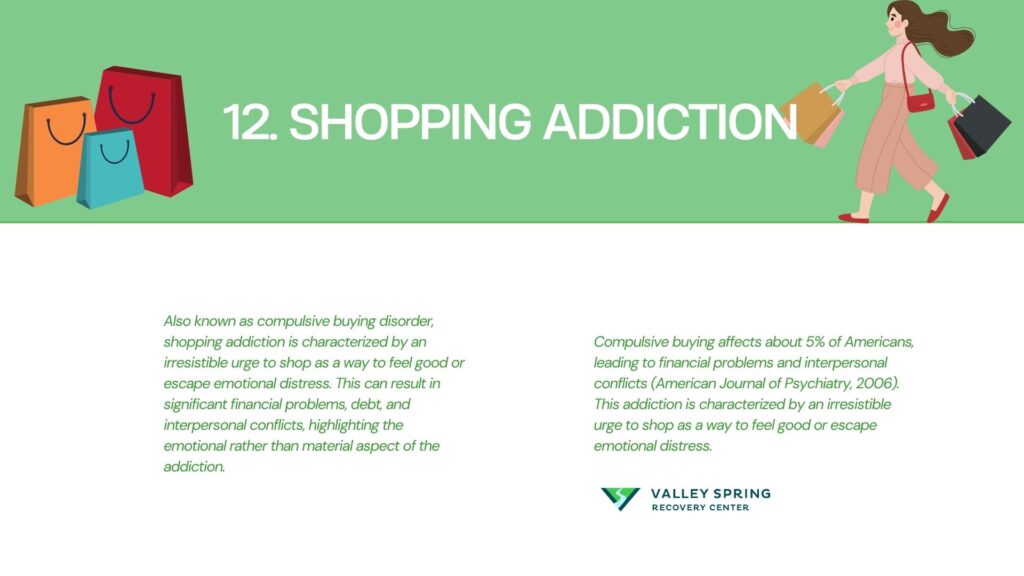
Also known as compulsive buying disorder, shopping addiction is characterized by an irresistible urge to shop as a way to feel good or escape emotional distress. This can result in significant financial problems, debt, and interpersonal conflicts, highlighting the emotional rather than material aspect of the addiction.
Compulsive buying affects about 5% of Americans, leading to financial problems and interpersonal conflicts (American Journal of Psychiatry, 2006). This addiction is characterized by an irresistible urge to shop as a way to feel good or escape emotional distress.
13. Food Addiction
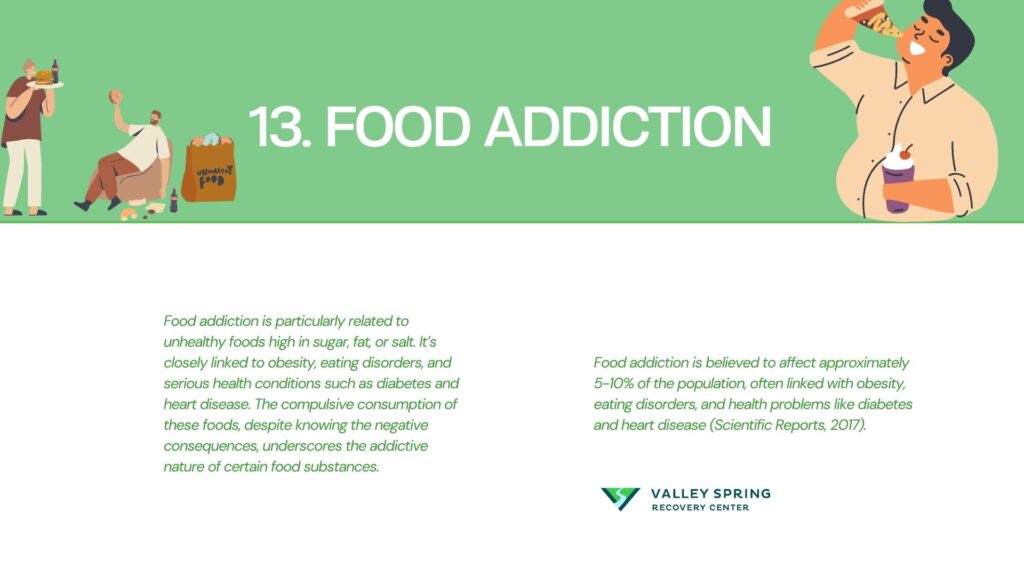
Food addiction is particularly related to unhealthy foods high in sugar, fat, or salt. It’s closely linked to obesity, eating disorders, and serious health conditions such as diabetes and heart disease. The compulsive consumption of these foods, despite knowing the negative consequences, underscores the addictive nature of certain food substances.
Food addiction is believed to affect approximately 5-10% of the population, often linked with obesity, eating disorders, and health problems like diabetes and heart disease (Scientific Reports, 2017).
14. Video Game Addiction
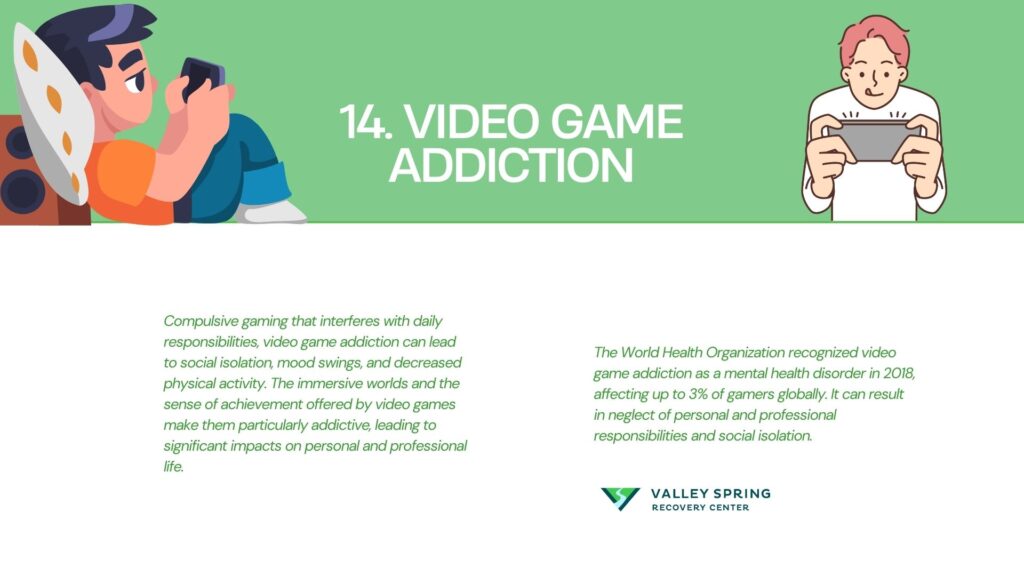
Compulsive gaming that interferes with daily responsibilities, video game addiction can lead to social isolation, mood swings, and decreased physical activity. The immersive worlds and the sense of achievement offered by video games make them particularly addictive, leading to significant impacts on personal and professional life.
The World Health Organization recognized video game addiction as a mental health disorder in 2018, affecting up to 3% of gamers globally. It can result in neglect of personal and professional responsibilities and social isolation.
15. Porn Addiction
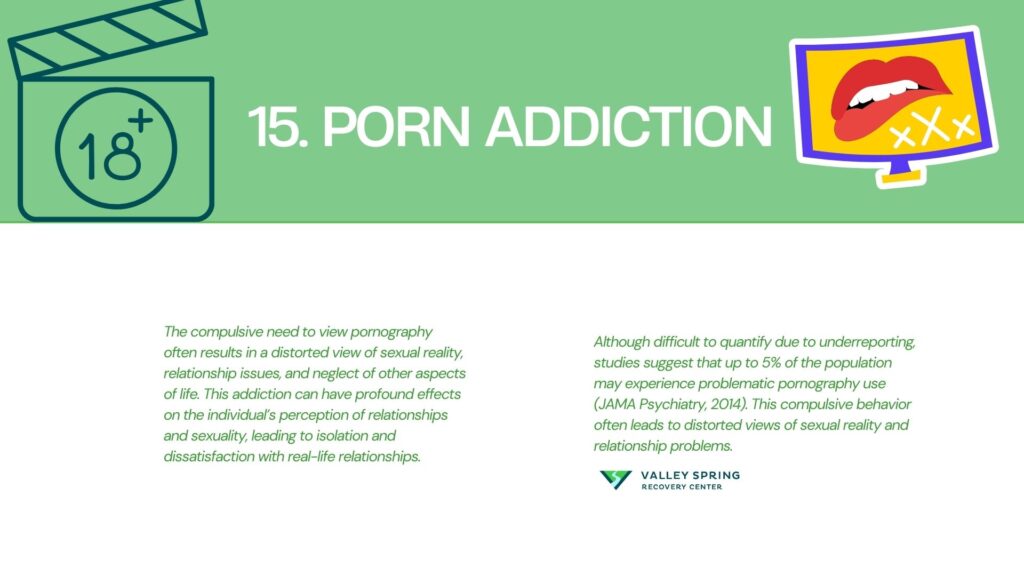
The compulsive need to view pornography often results in a distorted view of sexual reality, relationship issues, and neglect of other aspects of life. This addiction can have profound effects on the individual’s perception of relationships and sexuality, leading to isolation and dissatisfaction with real-life relationships.
Although difficult to quantify due to underreporting, studies suggest that up to 5% of the population may experience problematic pornography use (JAMA Psychiatry, 2014). This compulsive behavior often leads to distorted views of sexual reality and relationship problems.
The Valley Spring Editorial team found that porn addiction has recently shown an increase in search queries online with google trends highlighting the following search terms as breakout queries with 100% increase in 2024:
- porn addiction effects
- porn addiction symptoms
- porn addiction withdrawal
- porn addiction treatment
- porn addiction app
The increase in search volume for porn addiction may make it a viable candidate to move up the list of most frequent addictions in the future.

What is the definition of an addiction?
The definition of Addiction is a chronic condition where an individual engages compulsively in a substance or activity, despite harmful consequences. This condition is complex and develops through an intricate interplay of biological, psychological, and environmental factors. Genetically, some individuals are predisposed to addiction, making them more susceptible to addictive substances or behaviors. Psychologically, factors like stress, trauma, and mental health issues can drive individuals toward addictive behaviors as a coping mechanism. Environmentally, influences such as peer pressure, family dynamics, and socio-economic status play a crucial role.
The development of addiction often involves a cycle where initial voluntary use or behavior gradually becomes compulsive, driven by changes in brain chemistry and function. There are three different types of addictions including physical, behavioral and impulse control.
What Are Physical Addictions?
Physical addictions are characterized by the chronic or persistent use of substances that can lead to tolerance and dependency. These addictions encompass a range of substances, including alcohol, tobacco, opioids, marijuana, and cocaine. Several factors can contribute to the development of physical addiction, such as a family history of addiction, peer pressure, preexisting mental health conditions, imbalances in brain neurotransmitters, and attempts to cope with emotions or enhance productivity. The primary treatment methods for physical addictions typically involve counseling and detoxification.
What Are Behavioral Addictions?
In contrast to physical addictions, behavioral addictions do not involve substance use but instead revolve around compulsive engagement in maladaptive behaviors. Common types of behavioral addiction include sex addiction, food addiction, pornography addiction, work addiction, and exercise addiction. Behavioral addictions can have significant physical, mental, and social consequences for individuals. These addictions often stem from underlying mental health issues, life stressors, or changes in brain functioning. Treatment for behavioral addictions primarily involves psychotherapy, and individuals can seek assistance at treatment centers or rehabilitation facilities.
What Are Impulse Control Disorders?
Impulse control disorders are conditions characterized by urges and behaviors that pose a risk to oneself or others and lead to social impairments. These disorders involve a struggle to resist impulsive actions that can be excessive and harmful. Types of impulse control disorders include intermittent explosive disorder, kleptomania, gambling disorder, and pyromania. While genetics, social factors, environmental influences, and biological factors may contribute to these disorders, their precise causes remain uncertain. The primary approach to treating impulse control disorders involves therapy, often utilizing cognitive-behavioral therapy (CBT).

How Does the Treatment Change Based on Addiction Type?
The approach to addiction treatment significantly differs based on the type of addiction, as each form of addiction uniquely impacts an individual. This variation is primarily due to the differing nature of addictive substances and behaviors.
Treating addictions effectively requires a nuanced approach that recognizes the distinct differences between behavioral, physical, and impulse control addictions. Here’s a more detailed look at how treatment approaches can vary among these types of addiction:
Behavioral Addictions
Behavioral addictions (such as gambling, sex, internet, or shopping addiction) don’t involve a physical substance but are characterized by compulsive engagement in rewarding behaviors. Treatment typically includes:
- Cognitive Behavioral Therapy (CBT): Helps individuals identify and change negative thought patterns and behaviors.
- Motivational Interviewing: Increases an individual’s motivation to change and engage in treatment.
- Group Therapy: Provides support and helps individuals learn from the experiences of others with similar issues.
- Family Therapy: Addresses family dynamics and improves communication.
- Lifestyle Changes: Encourages healthier habits and activities that are incompatible with addictive behavior.
- Medication: Sometimes used to treat co-occurring conditions like depression or anxiety.
Physical Addictions
Physical addictions, particularly to substances like alcohol, opioids, or nicotine, involve physical dependence and withdrawal symptoms. Treatment often includes:
- Detoxification: Medically supervised withdrawal to safely manage withdrawal symptoms.
- Medication-Assisted Treatment (MAT): Uses medications, in combination with counseling and behavioral therapies, to treat substance use disorders.
- Counseling and Behavioral Therapies: Individual or group counseling focusing on understanding addiction and developing coping strategies.
- Support Groups: Groups like Alcoholics Anonymous (AA) or Narcotics Anonymous (NA) provide peer support.
- Dual Diagnosis Treatment: Addresses co-occurring mental health disorders.
Impulse Control Addictions
Impulse control disorders, such as kleptomania or intermittent explosive disorder, involve difficulties in controlling impulses that can harm oneself or others. Treatment may include:
- Cognitive Behavioral Therapy (CBT): Helps in recognizing impulses and developing control strategies.
- Medication: Certain medications, such as SSRIs or mood stabilizers, may be effective.
- Psychoeducation: Educating individuals about their condition and ways to manage it.
- Stress Management Techniques: Strategies like relaxation techniques or mindfulness can help in managing stress, which often triggers impulse control issues.
- Family Therapy: Can be useful in understanding family dynamics and improving relationships.
General Principles in Treating Addictions
- Individualized Treatment Plan: Tailoring treatment to the individual’s specific needs, history, and severity of addiction.
- Long-Term Follow-Up: Addiction is a chronic disorder requiring ongoing management and support.
- Holistic Approach: Addressing not just the addiction but also related health and psychosocial issues.
- Building a Support Network: Encouraging engagement with support groups or community resources.
In all cases, the goal of treatment is not just to stop the addictive behavior but to help individuals develop healthier coping mechanisms, rebuild relationships, and improve their overall quality of life.
What are the most expensive drugs?
The most expensive addictive drugs in terms of abuse include Cocaine, Heroin, and Methamphetamine due to their high street value and the costs associated with addiction, including healthcare, legal issues, and loss of productivity. Cocaine can cost between $80 to $100 per gram, Heroin around $15 to $20 per dose, and Methamphetamine $3 to $500 per gram, varying by region and purity.
What are the most unusual addictions?
Some of the most unusual addictions include eating non-food items (Pica), addiction to consuming dirt (Geophagy), extreme body modifications, addiction to drinking paint, compulsive hair pulling (Trichotillomania), and an obsession with being in a relationship (Relationship Addiction). These rare addictions and compulsions highlight the broad spectrum of human behavior and psychological conditions.
What brain chemicals and functions are involved in addiction?
The brain chemicals and functions involved in addiction encompass a wide range of neurotransmitters and brain regions that play critical roles in the reward, motivation, memory, and stress systems. Here’s a breakdown of key components according to the NIDA study on Drugs, Brains, and Behavior:
- Dopamine: Often referred to as the “feel-good” neurotransmitter, dopamine is central to the brain’s reward system. It’s released in large quantities in response to pleasurable activities, including drug use, reinforcing the behavior and making the individual want to repeat the experience.
- Serotonin: This neurotransmitter influences mood, appetite, and sleep. It’s also involved in drug addiction, where changes in serotonin levels can affect mood and anxiety, potentially influencing substance use behaviors.
- Oxytocin: Known as the “bonding hormone,” oxytocin has been linked to social interaction and stress reduction. Recent studies suggest it may also play a role in addiction by influencing social behaviors and stress responses related to substance use.
- Glutamate: Glutamate is the primary excitatory neurotransmitter in the brain and is crucial for learning and memory. In the context of addiction, alterations in glutamate pathways can affect the strength of drug cues and cravings, contributing to relapse.
- GABA (Gamma-Aminobutyric Acid): GABA is the main inhibitory neurotransmitter in the brain, helping to regulate excitability and reduce anxiety. Drugs that increase GABAergic activity can produce calming effects, which may be sought after by individuals with substance use disorders.
- Endorphins: These are the body’s natural painkillers, similar in structure to drugs like morphine. They are released in response to stress and pain but also in response to the use of certain drugs, contributing to feelings of euphoria.
Brain Functions and Regions Involved:
- The Reward Circuit: This includes areas such as the ventral tegmental area (VTA), nucleus accumbens, and prefrontal cortex. The reward circuit is activated by drug use and is responsible for the development of addiction.
- Amygdala and Hippocampus: These regions are involved in processing emotions and memory, respectively. They can associate certain environmental cues with drug use, leading to cravings.
- Prefrontal Cortex: Responsible for decision-making, impulse control, and self-regulation, the prefrontal cortex’s function can be impaired in addiction, leading to decreased control over substance use.
- Stress System: The brain’s stress systems, including the hypothalamus and pituitary gland, can influence addiction by affecting an individual’s response to stress and potentially increasing substance use as a coping mechanism.
Understanding the interplay between these neurotransmitters and brain regions is crucial for developing effective treatments for addiction.
Ben Fisher
All author postsShare This Post

